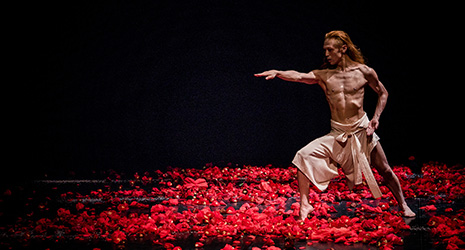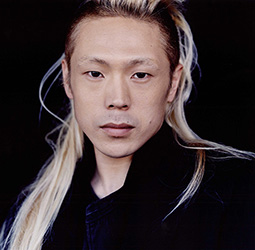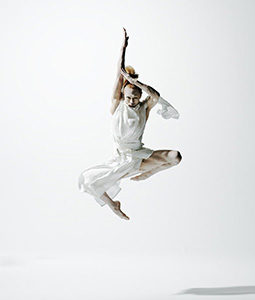Home > Highlighting JAPAN > Highlighting Japan December 2016 > Innovative Artists
Highlighting JAPAN


Joining Hands in Dance
Kaiji Moriyama’s unique style of dance continues to excite and engage audiences around the world.
Kaiji Moriyama is a contemporary dancer and choreographer known for his innovative style and ability to appear to float or cut through the air. Born in 1973, Moriyama started dancing at the age of 21, and after working with dance companies in Japan and abroad eventually went solo, producing his own works from 2001. Though he is technically skilled in tap, classical ballet and jazz dance, Moriyama’s style of expression is entirely his own.
“Expressing a sense of energy and promoting your existence realistically are among the attractive aspects of dance. But at the same time I am naturally fascinated by the expression of a sense of absence whereby ‘I am not here,’” says Moriyama. “Dance is abstract. When you get to the bottom of its expression, dance becomes ‘prayer’ itself. In other words, it is performed by a medium who mediates between the invisible world and the real world.”
Moriyama often takes themes and motifs from traditional Japanese performing arts such as noh drama as his subjects, but in expressing his themes frequently transcends genres, his performances being theatrical or notable for their costumes and music, for example. In 2013 he was appointed as a Japan Cultural Envoy by the Agency for Cultural Affairs and undertook exchanges with local children and artists through dance in Indonesia, Vietnam and Singapore. Moriyama says that the opportunity to observe a trance dance at a religious ceremony in Bali, in which nature, humanity and prayer become as one, was a particularly valuable experience for him in terms of reconfirming his own dance style.
In October this year, Moriyama reprised one of his most famous works, “Katana,” for the first time in ten years in Japan. When he first took the dance to New York and Montreal in 2005, “Katana” was described in the New York Times as “a dance of amazing concentration by an amazing dancer.”
“The katana [Japanese sword] is a very symbolic and profound theme,” says Moriyama. “Having a katana will result in a range of emotional conflicts. Will you use it as a weapon to kill somebody or as a means of protecting yourself? What is strength and weakness? What on earth is a human being? The energy of stillness and motion works concurrently within an act. Stillness does not mean suspension, but it is the state of various types of flow rotating within it. How can I exhibit this rotation without moving my body? That is one of the main issues of this repeat performance.”
Since 2010, Moriyama has brought his “Live Bone” collaborative show, with its outlandish skeletal costuming and rock-inflected score, to more than twenty cities in Japan and abroad. The energetic, often comical performance conveys the functions and possibilities of the human body.
One of Moriyama’s longtime performances is the “Global Handwashing Dance,” which was commissioned by the Japan Committee for UNICEF in 2009 to help promote “Global Handwashing Day,” October 15.
“I want children to realize the importance of handwashing and also foster their minds to join hands with various countries around the world through this dance,” says Moriyama. “I dance with children on Global Handwashing Day every year. Every single meeting becomes the first trigger in the creation of a new physical expression. In that sense, the next task is always my first goal and a new theme whose challenge I must take on.”
© 2009 Cabinet Office, Government of Japan








